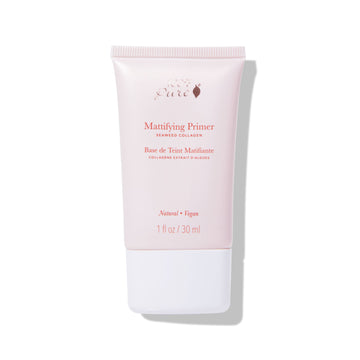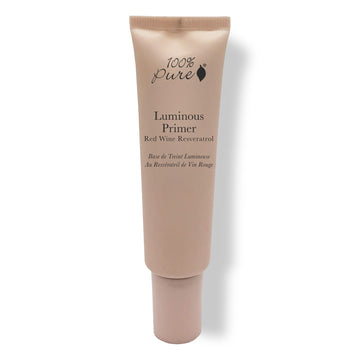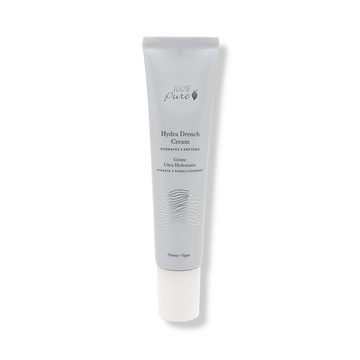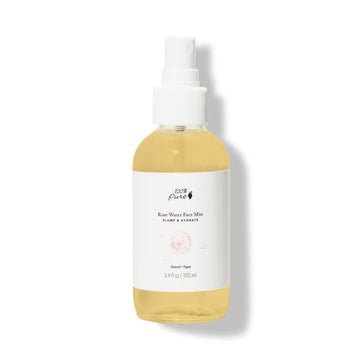Your Guide to Flawless, Long-Lasting Makeup in Any Weather
Posted on March 27, 2025 Written by: 100% PURE®
While luscious lipsticks and mega-volume mascaras are among the most commonly worn and prominent makeup items, primer is the primetime product that elevates the entire look. Flirty pouts and fluttery lashes are champion components in a cosmetic routine but primer changes the whole makeup game.
Face primers take one—or several—for the makeup team. They create a smooth, even canvas for makeup to adhere to, eliminating makeup fouls like fading, creasing, or separating. Primers act like a bridge between skincare and makeup, preparing the skin for follow-up beauty products.
From hydrating primers for dryness to color-correcting ones to stamp out discolorations, face primers improve makeup application, which allows all our other makeup products to perform at their peak.
In this post, we’ll dive into everything you need to know about primer–you’ll be able to answer questions such as:
What does primer do?
What is primer used for?
What does primer do for makeup?
By the end, you’ll know exactly how to avoid makeup fouls and make your makeup last all day for a total skin win!

What Is a Face Primer?
As its name suggests, a face primer prepares or ‘primes’ the skin for makeup, like how a primer is used for painting on a canvas. Is it that simple, or is there more to what is a face primer? There’s much more to makeup primers than meets the eye primer.
As the most important or ‘prime’ product in a makeup routine, a primer creates a better surface or makeup base for cosmetics and follow-up products to adhere to, just like paint for a canvas. Our skin is the canvas.
So, what does primer do for makeup? If foundation is the star player of your makeup game, face primers are the devoted teammates who ensure everything runs smoothly. Primer is a thin, lightweight product applied before foundation to create a smooth, even surface for makeup to adhere to – and stay put. It helps fill in fine lines, blur pores, and improve foundation longevity so makeup appears flawless.
Since a foundation primer performs multiple skin tasks, it makes sense this nearly undetectable layer would have a variety of prized players to cater to different individuals. Make up primers cater to different skin needs and concerns. Common face primer types include hydrating, mattifying, illuminating, color-correcting, and pore-refining, each with specific benefits detailed below.
#1. Hydrating Primers:
So, what is primer used for makeup, and how do hydrating primers benefit the skin?
Benefits: Ideal for dry, dehydrated, or mature skin, these primers help to hydrate and plump the skin, creating a smooth base for makeup and preventing it from settling into fine lines or looking cakey.
How they work: They contain ingredients, like hyaluronic acid or humectants like glycerin to draw moisture into the skin.
#2. Mattifying Primers:
What does makeup primer do, and why are mattifying primers good for controlling oil?
Benefits: Perfect for oily, combination, or acne-prone skin, these primers help to control oil production and create a matte finish, minimizing the appearance of pores and keeping makeup in place for longer.
How they work: They often contain ingredients, like silica or kaolin clay, to absorb excess oil.
#3. Illuminating Primers:
So, what is primer used for, and what are the benefits of illuminating primers?
Benefits: These primers add a subtle glow and radiance to the skin, making it appear brighter and more youthful. They are perfect for dull, tired-looking skin or anyone who wants a dewy, radiant finish.
How they work: They contain light-reflecting particles or pearlescent pigments that create a soft-focus effect. Our illuminating primers control natural, ethically sourced mica for a subtle sheen.
#4. Color-Correcting Primers:
For this make up primer, what skin types and concerns benefit from it?
Benefits: These primers are designed to neutralize specific skin concerns like redness, discoloration, or dark spots, creating a more even complexion before applying foundation.
How they work: They come in various colors (e.g., green for redness, yellow for dullness) that counteract the unwanted color.
#5. Pore-Refining Primers:
What is primer used for, and do pore-refining primers really work?
Benefits: These primers help to minimize the appearance of pores and create a smoother, more even-looking canvas for makeup application.
How they work: They often contain silicone-based ingredients that fill in pores and create a smooth surface.
Most primers contain silicone-based ingredients like dimethicone, which gives skin that silky-smooth texture and allows the foundation to glide on seamlessly.
What Does Primer Do for Your Makeup?
A face primer is one of the most game-changing products for achieving long-lasting makeup. By adding this nearly undetectable layer onto the skin before makeup, a foundation primer can help target specific skin concerns and allow our other makeup products to perform at their prime.
Let’s delve into what does makeup primer do, plus how it improves makeup application.
#1. Enhances foundation adherence
Face primer enhances foundation adherence by creating a smooth, even surface that allows the foundation to glide on effortlessly and stay in place longer. By creating a barrier between the skin and makeup, a makeup primer helps the foundation adhere better and last longer, preventing it from creasing, fading, or melting throughout the day.
#2. Smooths skin and minimizes texture
A face primer is designed to fill in fine lines, blur pores, and even out skin texture, creating a smoother, more even base for makeup application. The smooth, even application of foundation on a primed surface results in a more flawless, airbrushed look.
#3. Reduces oiliness and shine
A makeup primer reduces oiliness and shine by creating a thin, invisible layer on the skin's surface that helps absorb excess oil and mattify the skin, creating a smoother, more even base for makeup. While some primers can help reduce shine, choosing a mattifying formula designed for oily or combination skin can be very effective at controlling oil and eliminating shine.
#4. Provides hydration and nourishment
A face primer can provide hydration and nourishment through ingredients like hyaluronic acid, glycerin, and plant oils, which draw moisture into the skin and create a smooth, hydrated base for makeup application. Skin hydration is essential for optimal barrier function and overall skin health.
Studies on skin barrier function highlight the importance of protective layers in maintaining hydration and preventing irritation. Research like this study on skin barrier protection explains how occlusive ingredients (common in primers) and plant oils help reinforce skin defense mechanisms.
By incorporating makeup primer into your routine, you're not just extending the life of your makeup—you’re also giving your skin an extra layer of care and protection.
Best Primers for Different Climates & Weather Conditions
Most of us are familiar with swapping out our skincare products during seasonal changes. For example, the thin, lightweight moisturizer you may have been using during the sizzling summer months won’t give your skin adequate hydration during the dry, skin-moisture-sapping months.
If you do seasonal transitioning of your skincare products, you may need to swap out some of your beauty items depending on the climate and weather conditions where you reside and your skin type.
Humid climates:
In humid conditions, the air is already saturated with moisture, which makes it difficult for sweat to evaporate quickly. This leads to a buildup of sweat on the skin, which can cause makeup to slide off or become patchy. Sweat-resistant primers are crucial because they help prevent makeup from melting, smudging, or creasing due to excess moisture and humidity.
Product Feature: 100% PURE Mattifying Primer – A lightweight primer designed to control excess oil while providing a smooth, even base for foundation.
Cold weather:
Cold weather often brings dryness, emphasizing fine lines, dry patches, and uneven texture. To combat these challenges, using a hydrating and protective primer with ingredients like hyaluronic acid and glycerin is essential. A hydrating primer helps combat the dryness caused by harsh conditions, creating a smooth, plump canvas for makeup and preventing a cakey or patchy finish.
Hot and dry climates:
Hot and dry weather can cause your skin to produce more oil, leading to a shiny or greasy appearance. Heavy primers can feel suffocating in the heat and can cause makeup to slide off or crease, especially around the eyes and mouth. However, lightweight primers, especially those formulated for oil control, can help absorb excess oil and keep your skin feeling matte, fresh, and breathable.

How to Apply Primer for Different Makeup Looks
A flawless makeup application starts with the right base, and the perfect primer is key. Whether you're looking for a natural makeup look or glam-bam makeup for a night on the town, we’ll show you the details of these looks and how to properly apply our Luminous Primer for the most flawless, coveted looks.
This silicone-free, antioxidant-infused primer diffuses pores and illuminates with light-reflective pigment while giving flawless, long-lasting cosmetic application. It features a custom-crafted blend of jojoba oil, jojoba wax, silica, and rice starch and anti-aging resveratrol, nourishing vitamin E, and intensely hydrating aloe.
#1. Everyday natural makeup routine
An everyday natural makeup look emphasizes enhancing your natural features with minimal, subtle products, focusing on a "barely there" effect with products, like a face primer, tinted moisturizer, soft eyeshadow, a hint of blush, and mascara.
#2. Glam/full-coverage makeup
A glam makeup look is a bold and dramatic style that emphasizes enhancing natural features with a focus on a flawless base, dramatic eyes, and a statement lip, often incorporating techniques like contouring, highlighting, and voluminous lashes.
#3. No-makeup makeup look
If you’re going for a “no-makeup makeup look”, we have you covered. We understand the focus is on using minimal products and techniques to enhance your natural features, rather than concealing them. This subtle makeup style enhances natural features, creating the illusion of looking naturally radiant and put-together without appearing heavily made up.
Here’s how we apply our Luminous Primer for an added glow for any of these makeup looks:
#1. Start at the end of your skin routine. The most important requirement is that your skin is clean and hydrated. Your sunscreen should also be applied before your makeup primer.
#2. Squeeze out a pea-sized amount of primer and apply it with your fingertips. Dot the primer over the center of the face: the forehead, around the nose, and chin.
#3. We’ll use our fingertips again to distribute the product on each area of the face. It’s important not to rub or agitate the primer, as we want it to lay as smooth as possible. We simply sweep the product outward with the pads of our fingertips, covering the full face.
PRO-TIP: For oily/combo skin – or to get a targeted glow – only apply primer to selected areas.
#4. Next, smooth over the skin until evenly distributed. This primer works perfectly on the eyelids to enhance eyeshadow, or on the high points of the face to work as a light highlighter. It will also increase the impact of the highlighters you apply on top!
#5. Let the primer set for a minute to 90 seconds before applying your makeup. We use this time to apply lash primer and lip balm or put on our jewelry for the day.
Wear this face primer alone as a dewy moisturizer paired with brows, mascara, and gloss for a fresh, glowing face. You can also pair it with BB cream for light coverage or go right in with all your favorites for a full day-to-night beauty look.
Primer vs. Moisturizer vs. Setting Spray: What’s the Difference?
Prime, moisturize, set, oh my! With a plethora of products out there claiming to do this or that, it becomes essential to understand the differences between these skin- and make-up gems. A face primer preps skin for makeup application by creating a smooth canvas, a moisturizer hydrates and locks in moisture, and a setting spray locks makeup in place for a longer-lasting, flawless finish.
Let’s delve into a clear breakdown of our beloved face primers and how they each function differently.
This silicone-free primer is infused with skin-plumping seaweed collagen for flawless, long-lasting cosmetic application. It fills fine lines while minimizing shine.
There’s never a bad time for glowing, radiant skin. This primer is infused with age-fighting antioxidants to act as skincare for ageless skin while enhancing makeup with its hydrating and conditioning formula.
This lightweight moisturizer with a fast absorbing formula re-hydrates thirsty skin cells with soothing rose water and chia seed gel, a healthy source of beneficial omega fatty acids.
This soothing, balancing natural rose water spray delivers a kiss of hydration from rose water and hyaluronic acid for a plumped, youthful glow.
FAQs: What Is a Face Primer & Why It’s the Key to Perfect Makeup
Can I use a face primer without wearing a foundation?
Absolutely! A face primer can be worn on its own to smooth skin texture, control shine, and give a naturally polished look. Some primers, like our Luminous Primer, even provide added skincare benefits and a radiant glow.
What’s the best primer for oily skin?
If you have oily skin, opt for a mattifying primer like our Mattifying Primer, which helps absorb excess oil and keeps makeup from sliding off throughout the day. It contains ingredients like tea tree and green tea to help balance sebum production.
How do I stop my primer from pilling under makeup?
Pilling happens when skincare or primer doesn’t fully absorb before applying makeup. To avoid this, apply primer after your moisturizer has set for a minute or two. Use a thin, even layer and let it settle before layering the foundation.
Do I need a different primer for my eyes and lips?
Yes! Eye and lip primers are specifically designed to enhance wear time and prevent creasing in those areas. A face primer won’t grip eyeshadow or lipstick as effectively as dedicated primers, so use an eye primer for lids and a lip primer for smoother, longer-lasting color.
Can I mix primer with foundation?
You sure can! Mixing a primer with foundation can sheer out coverage and make application smoother. If you want a radiant glow, mix a luminous primer with foundation, or for a more airbrushed effect, mix with a mattifying primer.
Conclusion: Is Face Primer Worth It?
The verdict is in—yes, face primer is a must-have for anyone looking to enhance their makeup routine. Whether you need a glow boost, shine control, or just want to extend the wear of your makeup, the right primer makes all the difference. By choosing a primer suited to your skin type and makeup goals, you can create a flawless base that keeps your makeup looking fresh and polished all day long. So, next time you’re getting ready, don’t skip this game-changing step!
- Tags: March-2025
We carefully hand-select products based on strict purity standards, and only recommend products we feel meet this criteria. 100% PURE™ may earn a small commission for products purchased through affiliate links.
The information in this article is for educational use, and not intended to substitute professional medical advice, diagnosis, or treatment and should not be used as such.


















